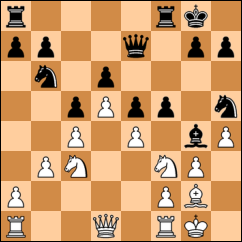K.Ammann–W.EngelRoute 20 Chess Club
Freeport, Ill., March 1, 2011
1.d4 d5 2.c4 e6 3.Nc3 Nf6 4.Bg5 Be7 5.Nf3 0-0 6.e3 Nbd7 7.Bd3
The first deviation from the main line Orthodox Queen's Gambit Declined. Black's most common reply to this variation is 7...dxc4 8.Bxc4, and his sharpest continuation is 8...c5; if white replies 9.dxc5, his chances after 9...Nxc5 aren't good. But after 9.0-0 a6 10.a4, as this game plays out, the odds are favorable to white.
7...dxc4 8.Bxc4 c5 9.0-0 a6 10.a4 Nb6?!
Threatening ...Nxc4, either before or after ...cxd4. But that knight is probably better off staying on d7, with other moves (10...b6, 10...cxd4, 10...Qc7, 10...h6) presenting themselves as just as valid.
11.Bd3 c4 12.Bc2 Bd7 13.b3
This is where Fritz begins nagging me to play Ne5. Depending on Will's response, I may be able to play 14.a5, kicking the defender off c4, then take with the centralized knight.
13...cxb3 14.Bxb3 Rc8 15.Qd3 Bb4
The alternative 15...Nbd5!? 16.Nxd5 Nxd5 17.Bxe7 Qxe7 takes command of the c-file.
16.Rfc1 Bc6 17.Bc2
Another missed opportunity to play Ne5, when the threat is now a minor piece trade on c6. 17.Bc2 is a good-looking but ineffectual move: the mate threat is easily stopped, either with the blunt 17...g6 (which Will chooses) or the agile 17...Nbd7!, which provides a backup defender for the pawn on h7 and discourages Ne5 as well.
17...g6
Time to go looking for a new plan. Immediate concern: A trade on f3 will double my pawns and leave my king exposed. My solution: think about what I'd rather have on that square besides a weak pawn.
18.Bd1
Fritz's solution: "Play 18.Ne5, stupid! You still gain by trading on c6, though you might want to consider first chasing black's knight off b6 with a5."
18...Kg7
Both Will and I seem to be missing the strategic importance of the e5-square -- of getting my knight onto it (Ne5), or of keeping my knight from getting onto it (...Nbd7).
19.a5
Fritz nags me one last time to play 19.Ne5 first, then, after due preparation, to trade on c6. In a moment, though, it's going to become moot.
19...Nbd5
Not a terrible move by any means, but the quieter 19...Nbd7! maintains a dead heat. The trade on d5, on the other hand, works out slightly to my advantage.
20.Nxd5 Qxd5
Considering I'm both playing against an opponent who's 800 points my superior and coming off a weeklong head cold, I flatter myself to think I've been doing a respectable job so far. Now, however, inexperience and fatigue catch up with me, and I don't think through my next move.
21.Qc4?!
Giving back the slight advantage I've just earned. It's not a blunder, it just fails to consider the true degree of risk of an exchange on f3 (why would Will lead with his queen?) or the potential merits of chasing his queen around a little. The best move is 21.Bb3!; if Will tries to keep up the attack on the f3-knight, which happens to be his best bet, 21...Qf5 22.Qxf5 gxf5 accomplishes the same goal as Qc4 (trading queens), messes up Will's kingside pawn structure and still allows a subsequent 23.Ne5. Another thing to consider -- which I do realize, but only after the fact -- is that the f6-knight is no longer pinned, and trading it off with 21.Bxf6 Kxf6 right now, before it can advance and become a nuisance, is a good idea.
21...Qxc4 22.Rxc4 Bxf3??
Will gives me a gift. 22...Bxa5 23.Rxa5 Bxf3 24.Rxc8 Rxc8 25.gxf3 Rc1! swings the game in his favor.
23.Rxb4 Bd5
Will doesn't follow up with the obvious 23...Bxd1 24.Rxd1 because, as I am, he's keeping an eye on his backward b-pawn. But suppose he plays 24...Rfd8 and I follow with 25.Rxb7. It turns out that this gets me nowhere: 25...Rd5! forks my bishop and my a-pawn, and material equality will be restored -- with a black rook behind my lines.
24.Bb3 Be4 25.f3! Bc6 26.Rc1
Meh . . . better to play 26.e4, continuing to throw caltrops in the path of Will's light-square bishop. (As a bonus, it also obstructs his knight and allows my bishop to protect the rook on c1.)
26...Nd5
This would not have been possible with 26.e4.
27.Bxd5 Bxd5 28.Rc5?!
All hat, no cattle. 28.e4 is still excellent, 28.Rxc8 Rxc8 is not bad, and even the passive-looking 28.Rbb1 has merit (for example, 28...f6 29.e4 Rxc1+ 30.Bxc1 Bc6 keeps material even and makes my spatial advantage stand out). In contrast, there's no good reason why Will shouldn't trade: 28...Rxc5 29.dxc5 f6 splits the lead pawn off the kingside chain, leaving me no particular advantage anywhere.
28...Rc6
It's not the objectively best move. But it's the right move. Because it's the one that tricks me.
I should play 29.e4, then allow the rook trade 29...Rxc5 dxc5, leaving me with a smidgen of extra space. But all my virus-addled patzer-brain can see is, "Hey! Hanging b-pawn!"
29.Rxb7?? Rxc5 30.dxc5 Bxb7
Ouch.
From here, I play a losing endgame about as well as it can be played.
31.Be7 Rc8 32.Kf2 f5 33.h3 e5 34.g4 e4 35.f4 Kf7 36.Bd6 Rc6 37.Kg3 Rxd6 38.cxd6 Bc8 39.Kh4 h6 (Will needs only play 39...Ke6 here to shut me down entirely) 40.g5 h5 41.Kg3 Ke6 42.Kf2 Kxd6 43.Ke2 Kc5 44.Kd2 Kb4 45.Kc2
Watch what Will does with his bishop and king now . . .
45...Be6 46.h4 Bc4 47.Kb2 Bb3
Dang, that's cold.
48.Kb1 Kxa5 49.Kb2 Kb4 (I can't even get out!) 50.Kb1 Kc3 51.Ka1 Bc2 52.Ka2 Kd2 53.Kb2 a5 (He does it again!) 54.Ka2 Kxe3 55.Kb2 Kd2 56.Ka3 e3 0-1
I resign here, knowing that I'm lost but not realizing that mate is only four moves away: 57.Kb2 e2 58.Ka2 e1Q 59.Kb2 Qb1+ 60.Ka3 Qb3#.
Two question marks may not be enough for 29.Rxb7??. There's no doubt about it: That is the move that loses this game.















